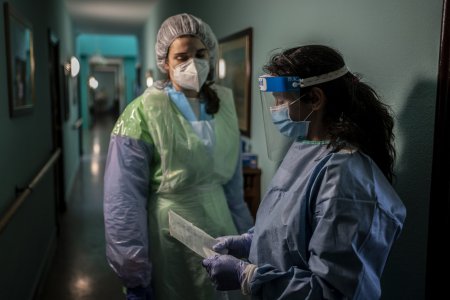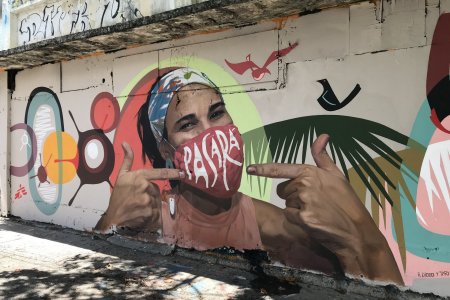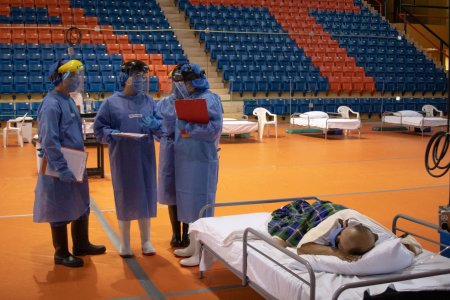
Covid-19 Reading List : the vaccines special edition
Michaël Neuman & Natalie Roberts
We can all agree that the emergence of Covid-19 vaccine is “an absolutely astonishing development”, but vaccines are unlikely to completely halt the spread of the virus, let alone eradicate it. Yet even without achieving herd immunity, the ability to vaccinate vulnerable people seems to be reducing hospitalizations and deaths from Covid-19. This article in Nature points out that although the disease might not disappear any time soon, we may soon be better able to live with it.
However, the devastating global impact of the pandemic is unlikely to end until there is adequate roll-out of these vaccines that protect against severe disease. Just having developed and licensed vaccines is not enough: they also need to be produced at scale, priced affordably, allocated rationally so that they are available where they are most needed, and deployed adequately widely – because a vaccine is no use just sitting in a vial in the fridge.
But before we all become too pessimistic about this pandemic potentially never ending, we should acknowledge the fact that over a few months in 2020 we saw the culmination of nearly a decade’s worth of technological breakthroughs. The pandemic has accelerated (at Warp Speed!) the development of a new arsenal of vaccine technologies, with mRNA at the forefront. But just why is everyone so so excited about mRNA vaccines?
Meanwhile teams are working on developing the second generation of vaccines, beyond just mRNA. This generation can potentially be manufactured more quickly and cheaply, don’t require difficult cold chain management, or can tackle virus variants.
A particularly promising candidate could be manufactured at massive scale using existing flu vaccine production sites, and has already entered clinical trials in Brazil, Mexico, Thailand and Vietnam.
And finally, some groups are working on producing the ‘super’ vaccine that will protect us from all coronaviruses, meaning we would no longer have to worry about the next SARS, MERS or Covid-19 : the technical explanation and the easy to read version - in fact you can even listen to it.
All very promising for the future, but in the short term there are just simply not enough vaccines to go around. The People’s Vaccine Alliance and many organisations (including MSF International) have called for intellectual property rights for Covid-19 vaccines to be suspended, claiming that would directly lead to an increase in global supply. But Charles Clift argues that promoting voluntary sharing of intellectual property and knowhow makes more practical sense than just waiving intellectual property rights.
This note by Maurice Cassier from the Cermes CNRS lab explores the feasibility (but not the desirability) of making the Covid vaccines into public goods. It emphasizes the huge number of actors that must be involved and the multiple questions that must be answered in order achieve this goal.
Although Cassier does not address the question of desirability, it was explored in this piece published in November 2020 for ID4D blog of l’Agence française de développement), back before any vaccine was being distributed.
This fascinating but somewhat complex article goes into finer detail about intellectual property rights to explain why even if Moderna agreed not to enforce patents on their vaccine, this is an empty gesture that will not increase vaccine supply. In fact, it seems that today’s patents are not even worth the cost of the paper they are written on.
So if calls to waive intellectual property rights alone are too simplistic, what can be done to increase global vaccine supply? To return to our star amongst the current crop of vaccines, no other platform may offer the flexibility and relatively low barrier to entry than mRNA technology. In this piece, Tom Frieden and Marine Buissonnière outline the steps the United States could take so that facilities in low- and middle-income countries can manufacture their own mRNA vaccines, including encouraging companies to transfer their technology and accompany these new manufacturing sites through the process.
But what is involved in manufacturing these mRNA vaccines? What does this technology and infrastructure that would need to be transferred to new manufacturing facilities actually look like? According to this interactive look at the Pfizer facilities in the USA, it’s not so simple – a complex manufacturing and testing process that takes 60 days, involves facilities in three US states, and requires purpose-built machines.
Despite all the challenges in scaling-up production, millions of vaccine doses are now being distributed worldwide. But even when vaccines are made available to countries, it does not mean they are being used. In Malawi, people are asking doctors how to flush the AstraZeneca vaccine from their bodies. In South Africa, health officials stopped giving the Johnson & Johnson shot, two months after dropping the AstraZeneca vaccine. And in the Democratic Republic of Congo, 1.7 million AstraZeneca doses went unused.
While the NYT article points the finger at safety fears and over-precaution in countries that can afford to be picky about which vaccines they use, anthropologist Oumy Thiongane argues that Western notions of vaccine hesitancy shouldn’t be naively applied in Africa, ignoring the political, social and pharmaceutical context and issues of inequality of access to care.
And this notion of ‘vaccine hesitancy’ is discussed further in this piece by historians of medicine Anne-Marie Moulin and Gaëtan Thomas, who argue that it appears really quite convenient to stop engaging with more sensitive questions around the governance of public health issues.
In practical terms, one of the key obstacles to wider deployment of vaccines is that the COVAX initiative does not cover implementation costs – COVAX’s responsibility ends once the vaccines hit the airport tarmac in the receiving country. Yet, as this article points out, vaccines don’t vaccinate; health-care workers do – and many countries already have too few health-care workers.
While in this blog, a Ugandan researcher and South African medical practitioner put the blame squarely on longstanding issues of corruption and denial in Sub-Saharan Africa: “African countries were reluctant to engage or put in place processes to procure the vaccine and now, there are cries around vaccine inequities and lack of equitable distribution. While there are definite inequities, developed countries are not solely to be blamed. Corruption, denialism, poor budgets, lack of procurement prioritisation and dependency on the COVID-19 Vaccine Global Access (COVAX) has led to the situation we find ourselves in as a continent”.
But Africa is not a country. So why, when Morocco has vaccinated 9 million people, has the DRC only vaccinated 2000 despite receiving nearly 2 million doses in early March? It seems to be a combination of precaution about the side effects of the AstraZeneca vaccine, a population that does not see an interest in being “guinea pigs”, and logistical difficulties.
Meanwhile South Africa, despite large epidemic peaks, has not fared much better than the DRC. Despite receiving vaccines earlier than most African countries, only 300 000 people have been vaccinated so far. Apart from the expected problems related to logistics, corruption and weak infrastructure, the country also chose to suspend the use of both the AstraZeneca and J+J vaccines.
And in Kano, Nigeria, specific concerns are being expressed about the Pfizer vaccine, given the history of a flawed clinical trial of a Pfizer-manufactured meningitis treatment in the 1990s.
It is probably a little too extreme to compare vaccination deployment in sub-Saharan Africa with Europe. Africa may not have any real vaccine production or distribution capacity, but mortality due to Covid-19 (even if largely under-reported) also remains fairly limited. But what about India? The country is facing a catastrophic epidemic wave, despite being one of the world’s largest vaccine manufacturers with a strong experience in deploying large-scale immunization programmes. So what went wrong? According to National Geographic, it's complicated.
To cite this content :
Michaël Neuman, Natalie Roberts, “Covid-19 Reading List : the vaccines special edition”, 7 mai 2021, URL : https://msf-crash.org/en/blog/medicine-and-public-health/covid-19-reading-list-vaccines-special-edition
If you would like to comment on this article, you can find us on social media or contact us here:
Contribute





Commentaires
L'utilisation généralisée d'un vaccin contre la COVID-19 ayant un taux d'efficacité d'au moins 50 % pourrait contrôler la pandémie de façon efficace. Merci beaucoup
Add new comment